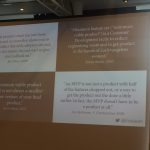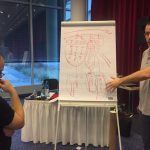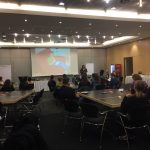Conference day 3 got off to a rousing start with Jessica DaVita: “I like to go fast and break things”. I think she was referring both to her passion for Moto GP and for software delivery. I liked her observation about a “wall of confusion” between Dev – “Change!” and Ops – “Stability!”
Safety matters, but Jessica observed, “No one ever says ‘We love our security team'”. As the recent Google research supported the concept that psychological safety is the best predictor of successful teams, we have to work on speaking a common language. Jessica explained that finding common ground doesn’t mean we all know the same stuff. Everyone has a unique skill set, but we all have pertinent mutual knowledge, beliefs, and assumptions. We lose that common ground in handoffs. She suggested a “Joint action ladder” to support common ground: Attend, perceive, understand and act.
Safety is conveyed through actions – code and conversation. Jessica says CODE is the only place to find TRUTH.
Another new voice!
Though it is always hard to pick a session for any given timeslot, I was keen to learn from Ash Coleman and her presentation, “Expectations, Adaptations and the Battle for Quality“. I felt this tied in a bit with Jessica’s keynote. Ash explained how we need to set expectations: What to test, how to keep track, how to communicate, how and when to interrupt.
The value of telling stories hit me again and again at this conference, and I loved Ash’s story about her mom, who said the greatest joke is making a plan. But Ash says we should make it anyway, and make alterations as needed. We have to ask questions. What’s working? What isn’t? What does success look like?
We have to cope with multiple communications, and contradictory bugs being reported. Ash suggests we give it time, celebrate small successes, plan for today. Recognize the lack of direction. Don’t sacrifice quality when conditions are changing. One aha learning for me here was that holding tight under pressure is a mistake. We need to learn what the forest looks like, make room for more trees, and decide where to focus. Ash urged us to frame quality, set clear expectations, think about our MVP, and – a theme that came up throughout the conference – let it go.
Designed to learn

Melissa Perri is one of my idols, I’ve learned so much about design from her. She talked about one of my favorite topics, experiments. Many lead nowhere, but we need them. Melissa noted that “MVP” (minimum viable product) does NOT equal your first release. It’s the minimum effort to let us learn.
I’m a fan of small experiments, an idea I learned from Linda Rising. Melissa recommends experiments to discover the reasons for users’ behavior. While only 1 in 20 experiments about the problem she described actually worked, they still learned from each experiment. Product strategy shouldn’t be a plan – plans fail (as Ash’s mom knew!). Instead, experiment to find out what customers want. Experiments sound scary – “We can’t experiment, it will affect our brand.” Melissa quoted Bill Beard, “Your brand is how people feel about your product or service.” Get it out fast and iterate. Solving big problems for customers creates big value for the business.
Melissa noted that if you go fast but you don’t do what you need to learn, you’re flapping, not flying.
Insights in Open Space

There is just sooo much to do at Agile Testing Days. I like to sample everything, which means giving up something else. I’d heard about a number of insightful sessions in the Open Space, which was facilitated by two of my favorite people, Alex Schladebeck and Olaf Lewitz. So this afternoon I finally got there. I’m so happy I did, because I got one of my biggest takeaways here.
Gojko Adzic (another one of my favorite people; Agile Testing Days is teeming with my favorite people) hosted a session about his TOO BIG heuristic for slicing stories. The acronym stands for Testable, Output, Outcome, Behavior change, Impact and Goal. The Outcome is the value to customer, the Behavior Change and Impact are the value to customers. The Goal is the value to the business, for example, market share, conversion rate, churn. This is a way to split stories. Gojko pointed out it is easier to split the problem than the solution. He recommends impact mapping before and after slicing the story.
Gojko said we need to measure value immediately after delivery. The delivery teams I’ve worked on tend to just put features out of mind after delivery and work on the next feature. It’s so important to learn what impact a new feature had on customers, users and the business. Gojko said the change in behavior brings the value you want, not the behavior itself. Lesson learned: If you want to slice a story, make sure it’s TOO BIG first.
Coaching Dojo
I spent the first afternoon session in the Open Space, but Gitte Klitgaard was kind enough to let me join the second half of her coaching dojo. Now, this is one thing I love about Agile Testing Days. Building quality into our software products requires a broad spectrum of skills. I’ve recently learned the value of shedding roles from Selena Delesie, in her Love2Lead course. Even if I’m not working as a “coach”, I have opportunities to lead and coach.
I got so much out of this hour of practice, and number one was learning to ask powerful questions. Here’s one I like: “What would you do if you knew you couldn’t fail?” We should ask open ended, probing questions. “How did it feel, how did it affect you?” We can be a mirror for our colleagues.
In the dojo, we had three roles, the listener, the seeker and the observer. Gitte asked observers to look out for defensive personal barriers and posture. I had the chance to be an observer and then a listener. I’m grateful to Mike Talks (did I mention my favorite people were here?) who played the seeker role. I found it hard to think of powerful questions, but Mike’s story was rather parallel to my own and I gained so many insights into my own issues as I listened to his experiences. This dojo delivered some of my most valuable takeaways.
Women in Agile Summit

The Women in Agile Summit reflected the conference organizers’ commitment to diversity. Maaret Pyhäjärvi (who had just been voted Most Influential Agile Testing Professional Person by her peers) facilitated the evening session. She set our context with an overview of the topic, then asked each table group to conduct a Lean Coffee discussion. Afterwards, each group shared what came up at their table. Interestingly, more people wandered in as we finished, and intense conversations continued. I had to chase people out of the room when it became clear that the hotel staff really needed to clear it up.
One of my aha moments in the Lean Coffee came from two men at our table. We were discussing what some of us saw as a tendency of men to “brag” more or be more assertive about their abilities. Two of our group were men from England whose faces registered horror at the idea of bragging about themselves. They clearly were not raised to “toot their own horns”, they were raised to be polite and unassuming. I realized that culture is important, regardless of gender.
Prior to this evening session, a group of us went out to dinner. When you’ve been enclosed in such an intense conference, sometimes you just have to get outside of it! Mike Talks asked us such an interesting question: What professional achievement are you most proud of? I enjoyed sharing these stories. This is a great example of how the experiences outside of the conference proper can be the most valuable.



One comment on “Agile Testing Days Conference Day 3 highlights”
[…] Agile Testing Days Conference Day 3 highlights – Lisa Crispin – https://lisacrispin.mystagingwebsite.com/2016/12/22/agile-testing-days-conference-day-3-highlights/ […]